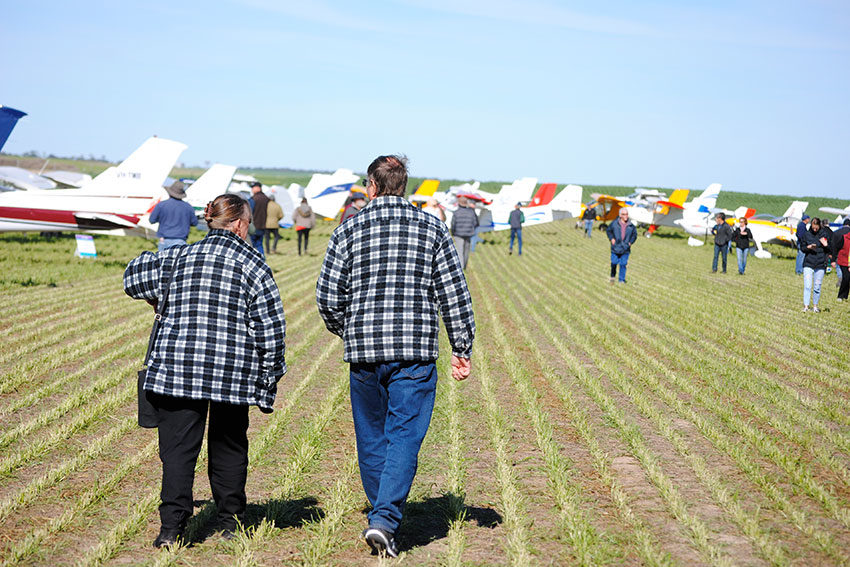Good Country: Airfields of Barley at Minlaton

The friendly Yorke Peninsula town of Minlaton has two main claims to fame: it’s the barley capital of the world and the home of aviation genius Harry Butler.
Visitors to Minlaton (established in 1876) may notice locals referring to their town as what sounds like ‘Millerton’. Intrigued by what happened to the ‘n’, I ask local writer Sheelagh Phillips. She says, laughing, “Other visitors have mentioned this. We use all the letters, but we use them quickly.” A Minlaton son who didn’t drop letters – despite carrying them from a great height – was Captain Harry Butler, who in 1919 made the first flight in the southern hemisphere to transport mail across water. This same flight, on 6 August 1919, was also histori c due to Butler being the first person to fly across the Gulf St Vincent from Adelaide to Minlaton.
As 2019 marks the centenary of this significant flight, Minlaton recently celebrated with a weekend devoted to Harry Butler. The Minlaton Town Hall hosted Butler-themed talks and book launches, and one outside wall of the hall became a giant projector screen for colourful footage of Butler flying.
History professor Peter Monteath, introducing the book at the launch, noted that “Australia was prominent in the development of aviation” and “a lot of the early aviators were mechanical geniuses”, which rural Australia seemed to cultivate. Monteath speculates that this focus on aviation could be due to the great distances in Australia.

More festivities for the centenary were held at Minlaton Aerodrome. These included vintage cars and motorbikes, sky jumpers and three-plane aerobatics, in which the planes narrowly missed each other while producing straight-edged clouds in the marbly blue skies. A helicopter was available for rides, and its bold yellow appearance and distinctive rotor-blade sounds added to the day’s enjoyment. A carnival atmosphere prevailed, with a Butler effigy woodcutting display and tantalising aromas from coffee vans, roast potatoes and smoky cola-marinated chicken wings. This exciting and different event was made even more special by the setting – an airfield reached by walking through a cleared path in a green barley field.
A highlight was a recreation of Butler’s flight, with a Tiger Moth plane flying mail from Adelaide to Minlaton. Butler’s original flight was in a red Bristol M1C monoplane called ‘The Red Devil’, now displayed in a hangar on Minlaton’s main street.
Butler had distinguished himself as a flying ace in the First World War. Due to his bravery and record-breaking flights, daredevil Butler attracted the same adulation as modern rock stars. In 1919, he pulled a crowd of 20,000 spectators at Unley Oval.
In the pioneering days of aviation, pilots’ average life expectancy after becoming pilots was between two to six weeks. Yet due to his consummate skills, Butler survived until the (still tragically young) age of 34. A bad plane crash outside of Minlaton in 1922 caused Butler serious injuries that probably led to his sudden death in 1924.

Apart from Minlaton’s ongoing pride in Butler, another aspect of his legacy relates to land he bought in Adelaide and named Hendon after the London aerodrome. This would become the first Adelaide airport and ultimately a suburb. Of course, Hendon still exists, as do several of its streets which are named after aircraft.
Butler began as a farm boy who wanted more than anything to become a pilot. Numerous knockbacks only strengthened his resolve. He willed his way to become a pilot, or, as he described himself, an ‘aeronaut’.
Pam Bennett (née Butler) co-wrote Farm Boy to Aeronaut with Phillips and other members of the Minlaton History Group, Michelle Hawthorne and Shirley Trevena. Bennett, whose grandfather Tom was Harry’s brother, admires Butler: “He really wanted to follow his dreams and was very determined. He had a lot of personality and charisma. His motto was ‘Luck, pluck and ability’, and he had a lot of each.”
Pam says, “Minlaton was the centre of aviation in its time. Harry Butler and the Red Devil go hand in hand with Minlaton. I’m very proud of how this centenary event has come together. Harry would be so pleased.” She adds in relation to her book, “Thank God it’s over. Three years working on it. I’m going home to prune the roses.”